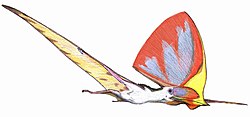| Vesperopterylus Temporal range: Aptian, | |
|---|---|
 | |
| Life reconstruction of Vesperopterylus on a tree branch | |
| Scientific classification | |
| Domain: | Eukaryota |
| Kingdom: | Animalia |
| Phylum: | Chordata |
| Order: | † Pterosauria |
| Family: | † Anurognathidae |
| Subfamily: | † Anurognathinae |
| Genus: | † Vesperopterylus Lü et al., 2017 |
| Type species | |
| †Vesperopterylus lamadongensis Lü et al., 2017 | |
Vesperopterylus (meaning "dusk wing") is a genus of anurognathid pterosaur from the Early Cretaceous Jiufotang Formation of China, the geologically youngest member of its group. Notably, Vesperopterylus appears to have a reversed first toe, which would have been suited for gripping; it was likely arboreal, climbing or clinging to tree branches with curved, sharp claws. It also has a relatively short tail, in contrast with its tailless ( Jeholopterus ) and long-tailed ( Dendrorhynchoides ) relatives. It was first described and named by Lü Junchang et al. While the original spelling of the name was Versperopterylus, this was a typo, and was emended by the authors in accordance with the International Code of Zoological Nomenclature. [1]














